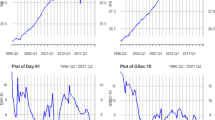Abstract
In this paper, we estimate a money demand function for a panel of five South Asian countries. We find that the money demand and its determinants, namely real income, real exchange rate and short-term domestic and foreign interest rates are cointegrated both for individual countries as well as for the panel, and panel long-run elasticities provide robust evidence of statistically significant relationships between money demand and its determinants. Our test for panel Granger causality suggests short-run causality running from all variables, except foreign interest rate, to money demand, and we find evidence that except for Nepal money demand functions are stable.
Similar content being viewed by others
References
Ahking FW (2002) Model mis-specification and Johansen’s co-integration analysis: an application to the US money demand. J Macro 24: 51–66
Bahmani-Oskooee, Rehman H (2005) Stability of money demand function in Asian developing countries. Appl Econ 37: 773–792
Bai J, Perron P (1998) Estimating and testing linear models with multiple structural changes. Econometrica 66: 47–78
Bai J, Perron P (2003) Computation and analysis of multiple structural change models. J Appl Econom 18: 1–22
Blanchard OJ, Quah D (1989) The dynamic effects of aggregate demand and supply disturbances. Am Econ Rev 79: 655–673
Calza A, Sousa J (2003) Why has broad money demand been more stable in the Euro area than in other economies? A literature review, European Central Bank Working Paper Series No.261
Caner M, Hansen BE (2001) Threshold autoregression with a unit root. Econometrica 69: 1555–1596
Dekle R, Pradhan M (1997) Financial liberalisation and money demand in ASEAN countries: implications for monetary policy. IMF Working Paper 97/36. IMF, Washington
Duca JV (1995) Should bond funds be added to M2. J Bank Financ 19: 131–152
Friedman M, Schwartz AJ (1963) A monetary history of the United States, 1867–1960. Princeton University Press, Princeton
Hamori N, Hamori S (1999) Stability of the money demand function in Germany. Appl Econ Lett 6: 329–332
Hamori S, Tokihisa A (2001) Seasonal cointegration and the money demand function: some evidence from Japan. Appl Econ Lett 8: 305–310
Hansen B (1992) Tests for parameter instability in regressions with I(1) processes. J Bus Econ Stat 10: 321–335
Harb N (2004) Money demand function: a heterogenous panel application. Appl Econ Lett 11: 551–555
Hoque A, Al-Mutairi N (1996) Financial deregulation, demand for narrow money and monetary policy in Australia. Appl Financ Econ 6: 301–305
Hueng CJ (1998) The demand for money in an open economy: some evidence for Canada. North Am J Econ Financ 9: 15–31
Khalid AM (1999) Modelling money demand in open economies: the case of selected Asian countries. Appl Econ 31: 1129–1135
King R, Plosser C, Stock JH, Watson MW (1991) Stochastic trends and economic fluctuations. Am Econ Rev 81: 819–840
Laidler DEW (1980) The demand for money in the US yet again. In: Brunner K, Meltzer A (eds) On the state of macroeconomics. Carnegie–Rochester Conference Series on Public Policy, p 12
Lown C, Peristiani S, Robinson KJ (1999) What was behind the M2 breakdown? Federal Reserve Bank of Dallas Financial Industry Studies Working Paper No. 02/1999
Mankiw NG (1991) The reincarnation of Keynesian economics, NBER Working Paper No. 3885
Mark NC, Sul D (2003) Cointegration vector estimation by panel DOLS and long-run money demand. Oxf Bull Econ Stat 65: 655–680
Mehra YP (1997) A review of the recent behaviour of M2 demand. Fed Res Bank Richmond Econ Q 83: 27–43
Pedroni P (1999) Critical values for cointegration tests in heterogenous panels with multiple regressors. Oxf Bull Econ Stat Special Issue 653–670
Pedroni P (2000) Fully modified OLS for heterogenous cointegrated panels. Adv Econ 15: 93–130
Phillips PCB, Hansen BE (1990) Statistical inference in instrumental variable regression with I(1) processes. Rev Econ Stud 57: 99–125
Pradhan BK, Subramanian A (2003) On the stability of demand for money in a developing economy: some empirical issues. J Dev Econ 72: 335–351
Ramajo J (2001) Time-varying parameter error correction models: the demand for money in Venezuela, 1983:1-1994:IV. Appl Econ 33: 771–782
Siddiki JU (2000) Demand for money in Bangladesh: a cointegration analysis. Appl Econ 32: 1977–1984
Weliwita A, Ekanayake EM (1998) Demand for money in Sri Lanka during the post-1977 period: a cointegration and error correction analysis. Appl Econ 30: 1219–1229
Westerlund J (2006) Testing for panel cointegration with multiple structural breaks. Oxf Bull Econ Stat 68: 101–132
Author information
Authors and Affiliations
Corresponding author
Rights and permissions
About this article
Cite this article
Narayan, P.K., Narayan, S. & Mishra, V. Estimating money demand functions for South Asian countries. Empir Econ 36, 685–696 (2009). https://doi.org/10.1007/s00181-008-0219-9
Received:
Accepted:
Published:
Issue Date:
DOI: https://doi.org/10.1007/s00181-008-0219-9




